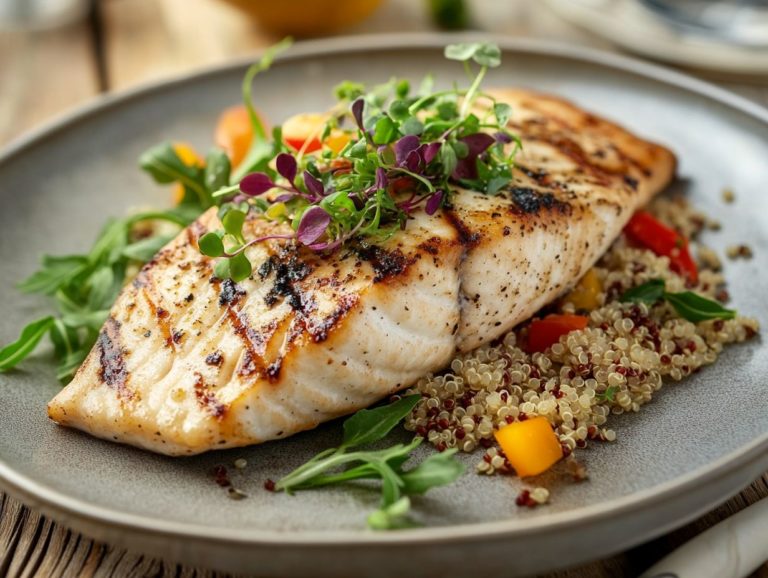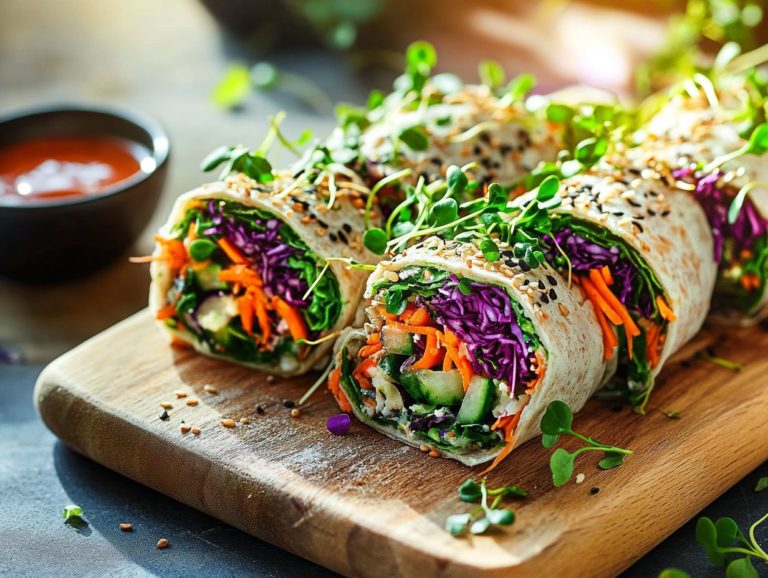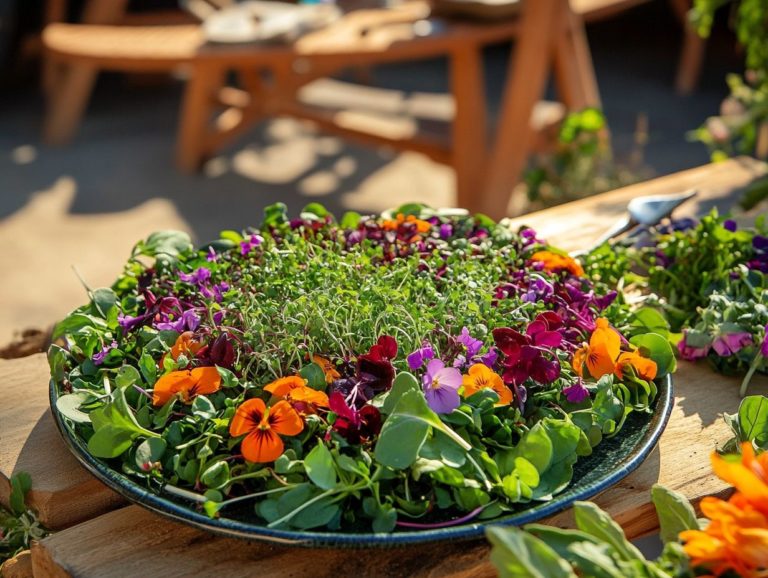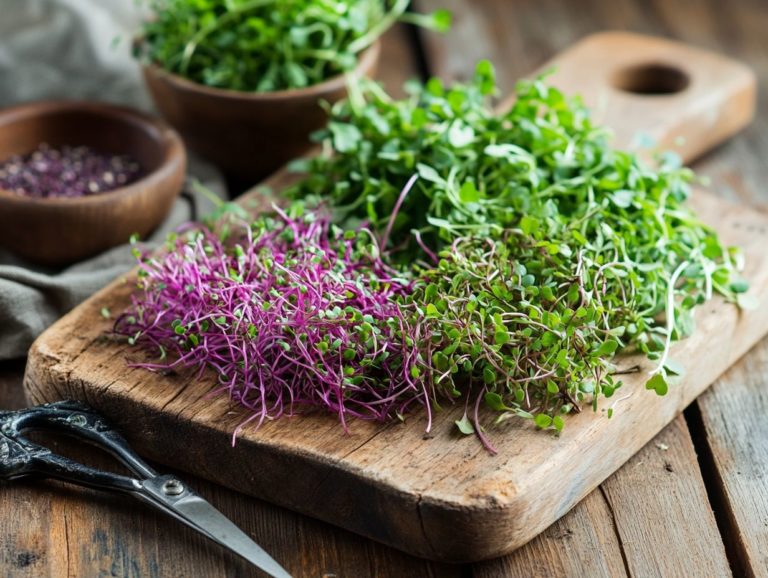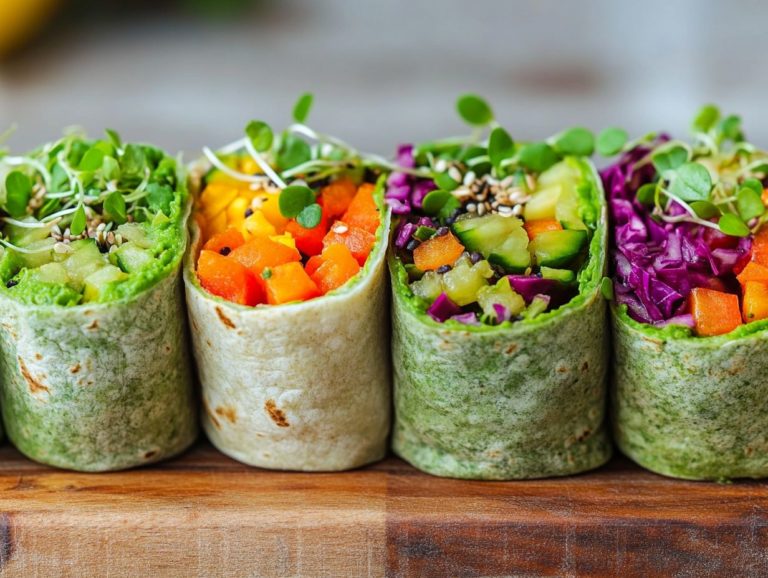17. Using Microgreens in Homemade Dressings
Microgreens are not just a trendy garnish. They deliver a burst of flavor and nutrition that elevates your homemade dressings.
This article delves into the world of microgreens and highlights their impressive nutritional benefits. You ll discover how to enhance your dressings with these tiny powerhouses, exploring healthy recipes that incorporate ingredients like crumbled feta and avocado.
Learn tips for seamlessly incorporating them into your recipes. Get creative with dressing ideas like lemon vinaigrette and creamy Italian dressing. Plus, find storage tips to keep them fresh. Get ready to transform your salads with vibrant microgreens!
Contents
- Key Takeaways:
- What are Microgreens?
- Benefits of Using Microgreens in Dressings
- Types of Microgreens to Use in Dressings
- How to Incorporate Microgreens into Dressings
- Simple and Delicious Microgreen Dressing Recipes
- Tips for Storing and Preserving Microgreens
- Frequently Asked Questions
- 1. What are microgreens and how do they enhance homemade dressings?
- 2. Which types of microgreens work best in homemade dressings?
- 3. Can microgreens be used as a substitute for fresh herbs in dressings?
- 4. How should microgreens be prepared before adding them to dressings?
- 5. How can I incorporate microgreens into my favorite dressing recipe?
- 6. Can I store homemade dressings with microgreens in the fridge?
Key Takeaways:

- Microgreens are nutrient-rich tiny greens that enhance your dressings!
- Using microgreens in dressings enhances the taste and nutritional value, making them a delicious addition to any dish.
- Popular microgreen varieties like basil, cilantro, and kale add a burst of freshness, perfect for quick meals.
What are Microgreens?
Microgreens are young, edible plants harvested right after their first true leaves emerge. They deliver a delightful explosion of flavor and nutrition. You can grow them from various seeds, such as Rambo radish and basil microgreens. They thrive in both hydroponic systems and soil, making them a great choice for organic and non-GMO options.
This versatility makes them an excellent addition to your healthy eating routine. These small greens are full of vitamins, minerals, and antioxidants, enhancing your balanced diet while providing an organic and non-GMO option for health-conscious eaters, especially those following raw vegan diets.
Definition and Nutritional Value
Microgreens are delightful little edible plants you encounter at the early growth stages, usually harvested within 7 to 21 days after germination. They re celebrated not just for their intense flavor but also for their remarkable nutritional benefits.
These tiny powerhouses are brimming with vitamins, minerals, and antioxidants. They play a crucial role in supporting your overall health, especially when combined with healthy recipes. For example, radish microgreens are loaded with vitamins A, C, and E, essential for bolstering your immune system and promoting skin health. Broccoli microgreens are equally impressive, containing high levels of sulforaphane, a compound known for its cancer-fighting properties.
Then there are beet and pea shoots, which provide iron and protein, making them superb additions to any balanced meal. By weaving these vibrant microgreens into your daily cooking, you can boost your nutrient intake while enjoying a burst of flavor in your dressings and sauces. To get the most out of these greens, learn how to harvest microgreens for salads.
Benefits of Using Microgreens in Dressings
Incorporating microgreens into your dressings elevates the flavor and nutritional profile of your dishes. Whether you’re crafting a light vinaigrette or a creamy Italian dressing, the vibrant colors and diverse flavors of microgreens will enhance the overall taste while delivering essential nutrients. They’re perfect for gourmet salads!
Packed with vitamins and minerals, these petite greens provide a powerful nutrient boost for salads and sauces. This supports your commitment to healthier eating.
Enhanced Flavor and Nutrient Boost
Microgreens significantly enhance the flavor profile of your dressings, adding a crisp, fresh taste that makes your salads and dishes truly special.
These tiny powerhouses not only bring vibrant colors to your creations but also infuse unique flavors, such as Rambo radish microgreens that provide a peppery kick, transforming simple dressings into gourmet delights. For instance, spicy varieties like arugula microgreens pair beautifully with balsamic vinaigrettes, adding a peppery kick that complements the sweetness of the vinegar and works well with crumbled feta. Meanwhile, basil microgreens provide a hint of sweetness and an aromatic twist to Italian dressings, while radish microgreens contribute a zesty crunch to citrus-based dressings. Explore more about creative uses for harvested microgreens to elevate your culinary creations.
Beyond just flavor, these greens packed with nutrients are loaded with vitamins and antioxidants, making your dressings not only tastier but also healthier. Every bite is packed with essential nutrients, enhancing both your meal and your well-being.
Types of Microgreens to Use in Dressings

When you re crafting dressings, there are many exciting microgreens to try, each boasting its own unique flavor profile and culinary benefits, including vegetables like spinach and cucumber. Consider popular varieties like basil microgreens, Rambo radish, spinach, and arugula, which can enhance your salads and dressings with their delightful textures.
Not only do these microgreens add vibrant colors to your dishes, but they also introduce delightful tastes and textures. They elevate everything from zesty vinaigrettes to indulgent, creamy sauces, enhancing the nutritional value of your salads and other meals. Discover 5 delicious ways to use freshly harvested microgreens to take your culinary creations to the next level.
Popular Varieties and Flavor Profiles
Among the popular varieties of microgreens, Rambo radish, basil microgreens, spinach, and arugula stand out with their amazing flavors and versatility in a multitude of dishes.
These vibrant greens not only introduce a splash of color to your plates, but they also offer a delightful range of taste experiences, especially when combined with ingredients like avocado and pine nuts that can elevate your culinary creations. Take the spicy, peppery notes of Rambo radish microgreens; they can transform a simple vinaigrette or add an unexpected kick to your classic potato salad. For more ideas, check out this guide on how to use microgreens in meal prep.
Then there’s the aromatic essence of basil microgreens, which infuses fresh basil pesto with a richer flavor, making them ideal for enhancing pasta dishes or topping off bruschetta, adding a healthy twist. Meanwhile, the mild, nutty flavor of arugula provides a refreshing contrast to richer dressings, creating a harmonious balance in your mixed greens salads. For those looking to elevate their meals further, check out these 5 must-try recipes featuring microgreens.
Don’t overlook spinach microgreens either; their delicate sweetness can effortlessly complement creamy dressings, such as those made with yogurt and garlic, delivering a nutrient-packed boost to any meal.
How to Incorporate Microgreens into Dressings
Incorporating microgreens into your dressings might seem challenging at first, but with a handful of straightforward cooking tips and tricks, you can effortlessly elevate your dishes.
Begin by choosing the right microgreens that harmonize with your dressing’s flavor profile, perhaps the peppery zest of Rambo radish or the subtle sweetness of basil microgreens, complemented by a dash of coarse sea salt. With these greens packed with nutrients in play, even a quick meal transforms into a gourmet experience, infusing your salads and sauces with a burst of freshness and a wealth of health benefits, especially when dressed with extra virgin olive oil. For more ideas, explore must-try microgreen varieties for salads.
Tips and Tricks for Adding Microgreens
Add microgreens to your dressings for a flavor boost. A few essential tips can help you unlock their best taste and nutrition.
Start with a small handful about one to two tablespoons of microgreens. This ensures you don’t overwhelm your dressing’s base, which could include olive oil and garlic. Gently mix them in with a whisk or fork, allowing them to blend seamlessly while maintaining their delightful texture. Peppery varieties like arugula microgreens enhance vinaigrettes, while sweeter options like pea shoots bring a refreshing element to creamy dressings. For more tips on improving your dishes, check out ways to enhance flavor in microgreens.
Experiment with different types; this will boost nutritional value and elevate your dishes’ overall flavor profiles.
Simple and Delicious Microgreen Dressing Recipes
Making delicious microgreen dressings at home is a fun way to enjoy vibrant flavors. You’ll unlock a treasure trove of nutrition in just minutes, making them perfect for quick meals.
Whether you crave a zesty lemon vinaigrette or a rich, creamy Italian dressing, incorporating microgreens like basil or Rambo radish will elevate your cooking experience.
These versatile recipes serve as delightful dressings and can also become excellent toppings for salads, crusty bread, and more, incorporating ingredients like avocado and pine nuts.
Step-by-Step Instructions for Homemade Dressings
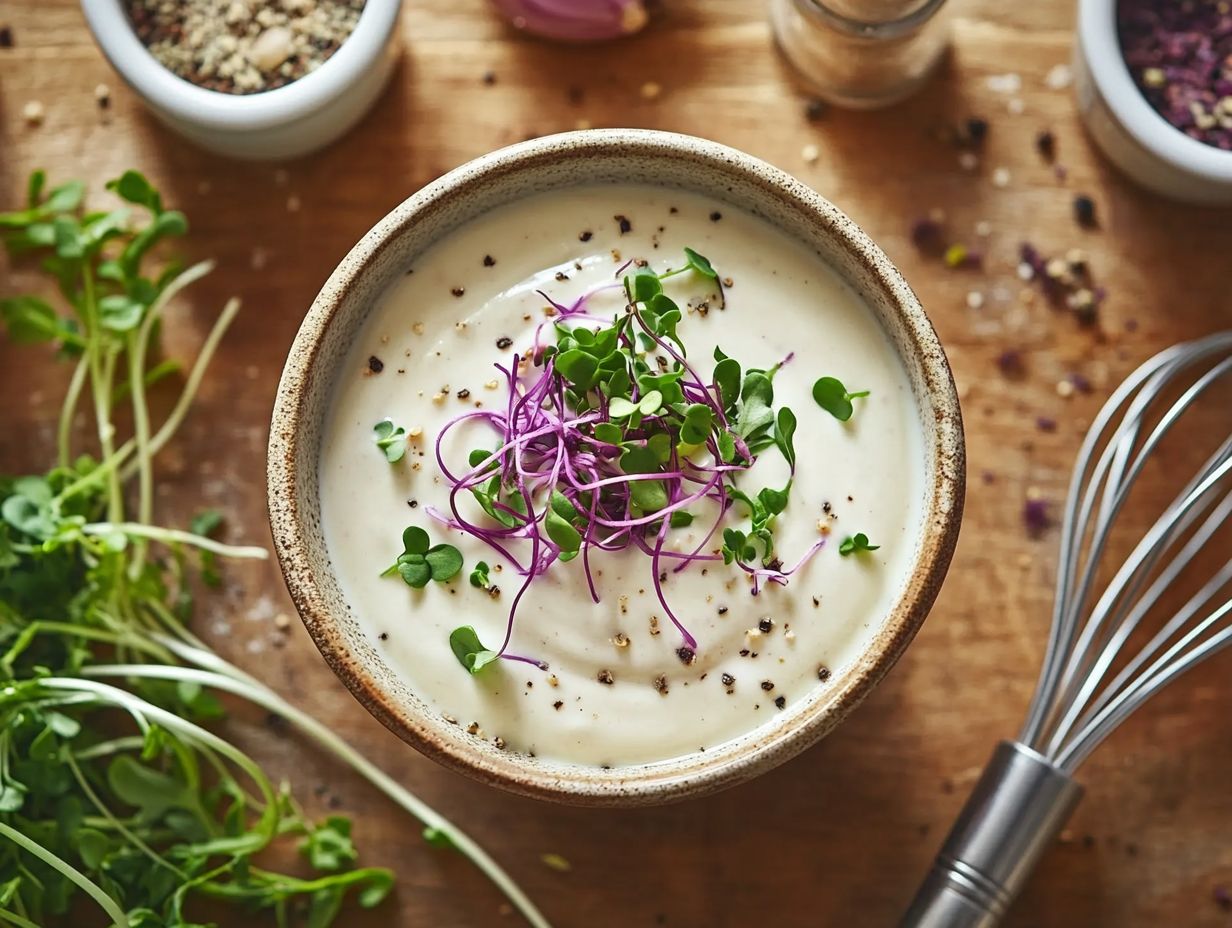
Making homemade dressings with microgreens isn t just easy; it s a game changer for your meals. Enrich them with organic food choices. By incorporating these nutrient-packed greens into your dressings, you can elevate flavors and add a health boost to your salads and sandwiches.
Start with a luscious base of olive oil or yogurt for creamy texture, then add a splash of apple cider vinegar or lemon juice to brighten the overall flavor. Mix in spices like garlic, mustard powder, or a touch of honey for a perfect hint of sweetness.
Now, stir in your choice of microgreens, such as arugula or pea shoots, to add vibrant color and a delightful peppery crunch. To learn more, check out how to incorporate microgreens into your diet. Whisk everything together until beautifully blended, and savor the delicious creation you’ve just made, perfect for drizzling over salads or crusty bread.
Tips for Storing and Preserving Microgreens
Proper storage and preservation techniques are crucial for maintaining the freshness and nutritional value of microgreens. This allows you to savor their benefits in your meals for extended periods.
By mastering the best methods to store these tender greens, you can effectively prevent spoilage and enhance their vibrant colors and flavors. Whether you’re working with microgreens grown in water or those sourced from local organic farms, these insights will keep your greens crisp and ready to elevate salads, dressings, or serve as a delightful raw vegan snack. For more tips, check out this guide on how to incorporate microgreens into your diet.
Proper Storage Techniques for Maximum Freshness
To ensure your microgreens stay fresh, proper storage is essential. Several techniques can help you achieve this goal.
One effective method is using airtight containers. They shield your greens from moisture loss and unwanted odors. Use glass jars or plastic clamshells both options let you see your vibrant greens while keeping a controlled environment.
Store your microgreens in the refrigerator at 32 F to 41 F to keep them tasty and nutritious. To enjoy the health benefits, consider 5 ways to incorporate microgreens into your diet by placing a damp paper towel alongside these delicate greens to provide humidity without adding extra moisture. This helps reduce wilting and spoilage.
Frequently Asked Questions
1. What are microgreens and how do they enhance homemade dressings?
Microgreens are tiny, young versions of edible vegetables and herbs. Packed with flavor and nutrients, they are a perfect addition to homemade dressings. Their delicate nature adds depth and complexity without overpowering other ingredients.
2. Which types of microgreens work best in homemade dressings?
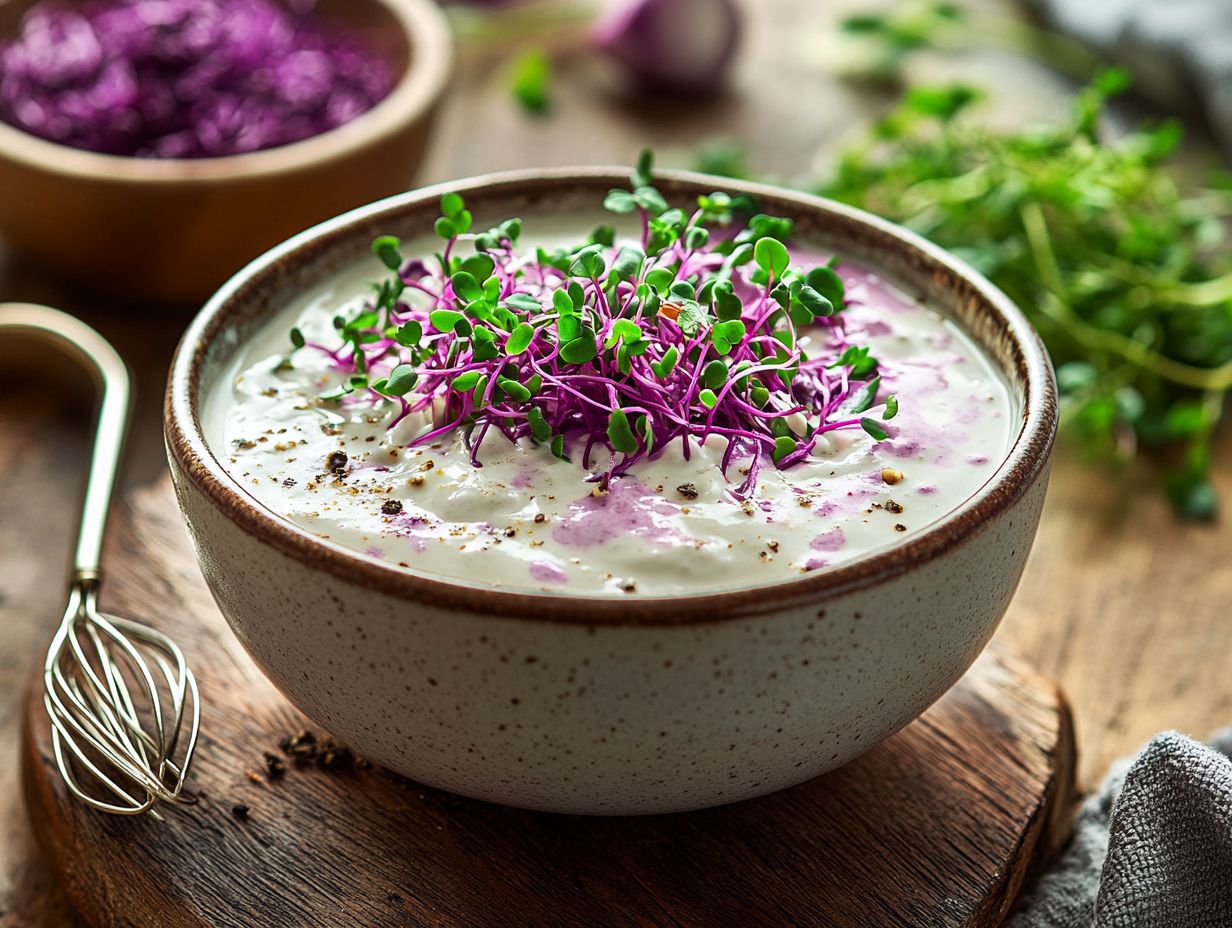
While all microgreens can enhance dressings, some varieties stand out. Popular options include arugula, basil, cilantro, and radish microgreens. Experiment with combinations to find your ideal flavor.
3. Can microgreens be used as a substitute for fresh herbs in dressings?
Yes! Microgreens can replace fresh herbs in dressings. They offer concentrated flavor and can be used in smaller amounts compared to traditional herbs. Plus, they are available year-round, making them a convenient alternative.
4. How should microgreens be prepared before adding them to dressings?
Before using microgreens, wash and dry them thoroughly. Remove any damaged or wilted leaves and trim the stems as necessary. Chop them finely or leave them whole, depending on your preference.
5. How can I incorporate microgreens into my favorite dressing recipe?
Adding microgreens to your dressing is simple. Blend them in with the other ingredients or use them as a garnish. You can also infuse your dressing by steeping microgreens in the oil or vinegar used in the recipe for a few hours.
6. Can I store homemade dressings with microgreens in the fridge?
Absolutely! Store your homemade dressings for a tasty treat later. However, consume them within a few days, as microgreens may wilt and lose their flavor over time. Alternatively, freeze the dressing in ice cube trays for longer shelf life.
Try using microgreens in your next dressing for a burst of flavor!

